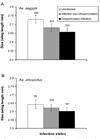Size alters susceptibility of vectors to dengue virus infection and dissemination
- PMID: 18981505
- PMCID: PMC2630770
Size alters susceptibility of vectors to dengue virus infection and dissemination
Abstract
The size of arthropod vectors may affect their ability to transmit pathogens. Here we test the hypothesis that body size alters the susceptibility of Aedes aegypti and Aedes albopictus mosquitoes to dengue virus (DENV) infection and subsequent dissemination throughout the body of the mosquito. After feeding on blood containing known quantities of virus, smaller-sized females were significantly more likely to become infected and to disseminate virus than larger individuals. The effects of size were stronger for Ae. aegypti and independent of rearing conditions. Ae. albopictus was more susceptible to DENV infection and had higher virus titer in the body than Ae. aegypti, yet infected Ae. aegypti disseminated DENV more readily than infected Ae. albopictus. These results are consistent with the concept that Ae. aegypti is a more competent vector of DENV and emphasize the importance of body size in determining adult infection parameters.
Figures


Similar articles
-
Vertical transmission of Key West dengue-1 virus by Aedes aegypti and Aedes albopictus (Diptera: Culicidae) mosquitoes from Florida.J Med Entomol. 2013 Nov;50(6):1291-7. doi: 10.1603/me13047. J Med Entomol. 2013. PMID: 24843934 Free PMC article.
-
Salinity tolerant Aedes aegypti and Ae. albopictus-Infection with dengue virus and contribution to dengue transmission in a coastal peninsula.J Vector Borne Dis. 2018 Jan-Mar;55(1):26-33. doi: 10.4103/0972-9062.234623. J Vector Borne Dis. 2018. PMID: 29916445
-
Vector competence of Aedes albopictus and Aedes aegypti (Diptera: Culicidae) for DEN2-43 and New Guinea C virus strains of dengue 2 virus.Acta Trop. 2013 Dec;128(3):566-70. doi: 10.1016/j.actatropica.2013.08.006. Epub 2013 Aug 17. Acta Trop. 2013. PMID: 23962388
-
Infection and dissemination of dengue virus type 2 in Aedes aegypti, Aedes albopictus, and Aedes scutellaris from the Torres Strait, Australia.J Am Mosq Control Assoc. 2007 Dec;23(4):383-8. doi: 10.2987/5598.1. J Am Mosq Control Assoc. 2007. PMID: 18240514
-
Consequences of the expanding global distribution of Aedes albopictus for dengue virus transmission.PLoS Negl Trop Dis. 2010 May 25;4(5):e646. doi: 10.1371/journal.pntd.0000646. PLoS Negl Trop Dis. 2010. PMID: 20520794 Free PMC article. Review.
Cited by
-
Modulation of La Crosse Virus Infection in Aedes albopictus Mosquitoes Following Larval Exposure to Coffee Extracts.Front Physiol. 2012 Mar 28;3:66. doi: 10.3389/fphys.2012.00066. eCollection 2012. Front Physiol. 2012. PMID: 22470349 Free PMC article.
-
Entomological assessment of tsetse-borne trypanosome risk in the Shimba Hills human-wildlife-livestock interface, Kenya.Front Vet Sci. 2022 Aug 16;9:931078. doi: 10.3389/fvets.2022.931078. eCollection 2022. Front Vet Sci. 2022. PMID: 36051538 Free PMC article.
-
Linking Water Quality to Aedes aegypti and Zika in Flood-Prone Neighborhoods.Ecohealth. 2019 Jun;16(2):191-209. doi: 10.1007/s10393-019-01406-6. Epub 2019 Apr 3. Ecohealth. 2019. PMID: 30945160 Free PMC article.
-
Environmental conditions in water storage drums and influences on Aedes aegypti in Trinidad, West Indies.Acta Trop. 2009 Oct;112(1):59-66. doi: 10.1016/j.actatropica.2009.06.008. Epub 2009 Jun 17. Acta Trop. 2009. PMID: 19539592 Free PMC article.
-
Taking a bite out of nutrition and arbovirus infection.PLoS Negl Trop Dis. 2018 Mar 29;12(3):e0006247. doi: 10.1371/journal.pntd.0006247. eCollection 2018 Mar. PLoS Negl Trop Dis. 2018. PMID: 29596427 Free PMC article. Review.
References
-
- O’Meara GF, Evans LF, Jr, Gettman AD, Cuda JP. Spread of Aedes albopictus and decline of Ae. aegypti (Diptera: Culicidae) in Florida. J Med Entomol. 1995;32:554–562. - PubMed
-
- Werner EE, Gilliam JF. The ontogenetic niche and species interactions in size-structured populations. Ann Rev Ecol Systematics. 1984;15:393–425.
-
- Osenberg CW, Mittelbach GG, Wainwright PC. Two-stage life histories in fish: the interactions between juvenile competition and adult performance. Ecology. 1992;73:255–267.
Publication types
MeSH terms
Substances
Grants and funding
LinkOut - more resources
Full Text Sources
Medical
